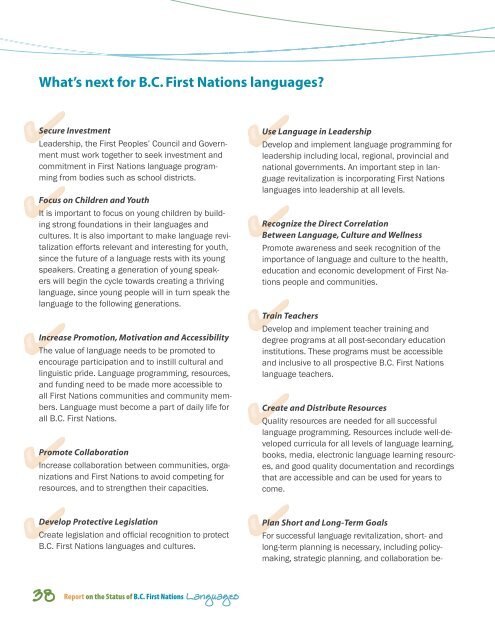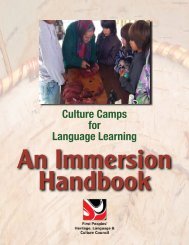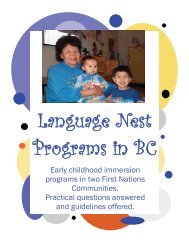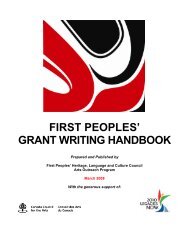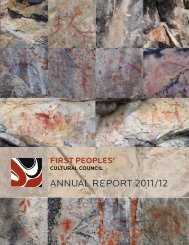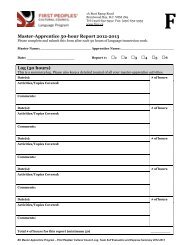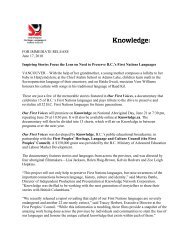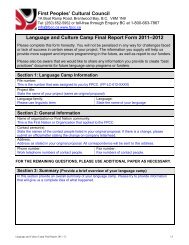What is the status of BC First nations languages? - First Peoples
What is the status of BC First nations languages? - First Peoples
What is the status of BC First nations languages? - First Peoples
Create successful ePaper yourself
Turn your PDF publications into a flip-book with our unique Google optimized e-Paper software.
<strong>What</strong>’s next for B.C. <strong>First</strong> Nations <strong>languages</strong>?Secure InvestmentLeadership, <strong>the</strong> <strong>First</strong> <strong>Peoples</strong>’ Council and Governmentmust work toge<strong>the</strong>r to seek investment andcommitment in <strong>First</strong> Nations language programmingfrom bodies such as school d<strong>is</strong>tricts.Focus on Children and YouthIt <strong>is</strong> important to focus on young children by buildingstrong foundations in <strong>the</strong>ir <strong>languages</strong> andcultures. It <strong>is</strong> also important to make language revitalizationefforts relevant and interesting for youth,since <strong>the</strong> future <strong>of</strong> a language rests with its youngspeakers. Creating a generation <strong>of</strong> young speakerswill begin <strong>the</strong> cycle towards creating a thrivinglanguage, since young people will in turn speak <strong>the</strong>language to <strong>the</strong> following generations.Increase Promotion, Motivation and AccessibilityThe value <strong>of</strong> language needs to be promoted toencourage participation and to instill cultural andlingu<strong>is</strong>tic pride. Language programming, resources,and funding need to be made more accessible toall <strong>First</strong> Nations communities and community members.Language must become a part <strong>of</strong> daily life forall B.C. <strong>First</strong> Nations.Promote CollaborationIncrease collaboration between communities, organizationsand <strong>First</strong> Nations to avoid competing forresources, and to streng<strong>the</strong>n <strong>the</strong>ir capacities.Use Language in LeadershipDevelop and implement language programming forleadership including local, regional, provincial andnational governments. An important step in languagerevitalization <strong>is</strong> incorporating <strong>First</strong> Nations<strong>languages</strong> into leadership at all levels.Recognize <strong>the</strong> Direct CorrelationBetween Language, Culture and WellnessPromote awareness and seek recognition <strong>of</strong> <strong>the</strong>importance <strong>of</strong> language and culture to <strong>the</strong> health,education and economic development <strong>of</strong> <strong>First</strong> Nationspeople and communities.Train TeachersDevelop and implement teacher training anddegree programs at all post-secondary educationinstitutions. These programs must be accessibleand inclusive to all prospective B.C. <strong>First</strong> Nationslanguage teachers.Create and D<strong>is</strong>tribute ResourcesQuality resources are needed for all successfullanguage programming. Resources include well-developedcurricula for all levels <strong>of</strong> language learning,books, media, electronic language learning resources,and good quality documentation and recordingsthat are accessible and can be used for years tocome.Develop Protective Leg<strong>is</strong>lationCreate leg<strong>is</strong>lation and <strong>of</strong>ficial recognition to protectB.C. <strong>First</strong> Nations <strong>languages</strong> and cultures.Plan Short and Long-Term GoalsFor successful language revitalization, short- andlong-term planning <strong>is</strong> necessary, including policymaking,strategic planning, and collaboration be-38Report on <strong>the</strong> Status <strong>of</strong> B.C. <strong>First</strong> Nations Languages


